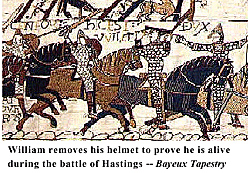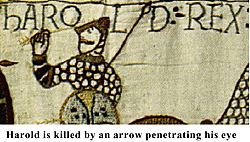The stage was set for a trial by combat between three great lords with the death of King Edward the Confessor. The three lords vying for the throne were Harold Godwinson, the Earl of Wessex, most powerful lord in Anglo-Saxon England; King Harald Hardrada of Norway; and finally, Duke William of Normandy. It was Harold Godwinson who grabbed the throne after the death of King Edward on 5 January 1066 and had himself crowned just a few days later. While Harold might have had the English crown, it would not be kept without him defeating his two rivals in battle.
King Harold was faced with the problem of which of his rivals would move first in their invasion of England. At first, it appeared that it would be Duke William who had constructed a large fleet and brought together a large force of Normans to challenge King Harold. This led King Harold to call out the fyrd and station it along the southeastern shores of England. However, Duke William was faced with unfavorable winds and could not cross the English Channel at this time. This delay led King Harold to stand down his fyrd because their required period of service had been met and provisions had been exhausted.
No sooner had King Harold stood down his forces than news reached him that the force of Harald Hardrada had landed in the north during the first week of September. A few days later, Hardradaís forces had defeated an Anglo-Saxon force under the command of Earls Edwin and Morcar at Gate Fulford. King Harold immediately recalled the fyrd to a forced march which arrived at Stamford Bridge, catching the forces of Harald Hardrada by surprise and soundly defeating them. In the battle, Harald Hardrada was killed, as well as most of his forces.
While this was a great victory for King Harold, one must remember that the great battles of this day were bloody slugfests with both sides taking a large number of casualties. Also, as stated earlier, the elite forces were always in the forefront of the battle and would have been the majority of the dead and wounded. No sooner had King Harold defeated the Nordic threat in the area of York than he received news that the winds in the channel had changed. Duke Williamís forces had landed at Pevensey and were burning and looting the countryside.
King Harold and his forces marched from York and arrived in the vicinity of Hastings on 13 October. During Haroldís forced march, he had left behind a large number of his forces which could not keep up with the seventeen miles a day marching pace it took him to arrive in this short time.
Scholars have questioned the reasons why King Harold closed and gave battle to Duke Williamís forces so quickly. There are three schools of thought on why King Harold so quickly gave battle to the forces of Duke William. Time was on King Haroldís side. The longer he waited for battle, the stronger his forces would have been and Duke Williamís supplies could not have lasted indefinitely.
The first school of thought is that Harold felt duty-bound to protect the English countryside in Wessex, of which he was the Earl, and that he had to stop the Norman plundering and razing. The second school of thought is that Harold hoped to catch the Norman forces by surprise, much like he had against the forces of Harald Hardrada in the north just weeks earlier.
And the final school of thought is that he could not count on any additional forces arriving, and there was a great possibility that the forces of Earls Edwin and Morcar would throw in with Duke William and give him even more of an advantage. Whatever the reason for King Harold giving battle so quickly with Duke Williamís forces, the die had been cast.
Clash of Arms
On the morning of 14 October 1066 at approximately 0900 AM, the battle of Hastings commenced with the forces of King Harold attempting to take their position on a small rise in the terrain. However, Harold would not achieve the surprise he had hoped for, but was, himself, taken by surprise with the rapidly-approaching Norman forces. Yet, Harold was in a good defensive position by the time that the first shower of arrows fell upon his forces, and sustained few casualties. He had his forces take up position on a rise that would force the Norman forces to attack uphill. Due to the incline and marshy surrounding terrain, Harold had ensured that he could not be flanked.
After William had launched his arrow barrage, he sent in his heavy infantry which met with no success due to the strength of the Anglo-Saxon shield wall. The shield wall is said to have been 8 to 12 ranks deep and extended the entire width of the rise. William next sent in his mounted knights in an attempt to break the shield wall and route his enemy. It was during this phase of the battle that the Bretons fell back in disarray, which led to the Anglo-Saxons breaking their own shield wall to give pursuit of their fleeing enemy. Also, at this time the rumor of Williamís death spread through the Norman ranks and they began to buckle.
 William removes his helmet to prove he is alive during the battle of Hastings -- Bayeux Tapestry
William removes his helmet to prove he is alive during the battle of Hastings -- Bayeux Tapestry
It was only when William removed his helmet and rode up and down the ranks that order was restored. The Anglo-Saxon forces that had left the protection of the shield wall in their pursuit of the fleeing Bretons were quickly encircled and slaughtered by the Norman knights. With this opening thrust, Haroldís only real chance of victory came to an end. The battle would continue on for most of the day with the Normans utilizing the ruse of retreat twice more, with the Anglo-Saxons falling for the bait each time, only to be cut off and killed.
By this time, King Haroldís shield wall no longer had its initial strength. By late afternoon, fatigue began to show clearly in the Anglo-Saxon forces that had just days earlier completed a forced march of over two hundred miles to counter the present threat. It was then that King Harold was wounded in the eye by a Norman arrow and soon thereafter was killed in battle by the Norman forces.
 Harold is killed by an arrow penetrating his eye
Harold is killed by an arrow penetrating his eye
As a direct result, the Anglo-Saxon fyrd broke up with the levies fleeing in retreat and the huscarles and thegns preparing for their duty in the final battle to the death around their fallen king. Duke William sent his forces in pursuit of the fleeing Anglo-Saxons. At nightfall, he recalled his forces due to limited visibility and the possibility of ambush in unfamiliar territory. So ended the Battle of Hastings with most of the Anglo-Saxon leadership dying on the battlefield.
William the Conqueror
William, with the defeat of the Anglo-Saxon forces at the Battle of Hastings, had his victory. His major competitors for the English throne had all perished. On 25 December 1066 Duke William was crowned the King of England at Westminster and took the new title of ďWilliam the Conqueror.Ē However, his conquest of England had just begun and the fighting to secure his newly-won crown was to last from 1066 until his death in 1087. There would be numerous revolts and uprisings against Norman rule, but in the end Saxon England would fall totally under the control of William. He accomplished this by constructing castles in strategic locations to control the territories he had taken by force of arms and to utilize them as secure bases for further offensive operations.
William the Conquerorís victory at the Battle of Hastings and his being crowned the King of England on 25 December 1066 helped to consolidate his power, but he still had a long and dangerous road before him until England was subdued. He now had to either defeat the widely spread Anglo-Saxon lords who were still located throughout the rest of England, or have them embrace his Kingship.
He first attempted to persuade the Anglo-Saxon lords through diplomatic offerings, but was betrayed repeatedly. He also had to face rebellious Norman lords who wanted more of the fruits of victory than he was willing to award them. This forced William to engage in punitive campaigns to subdue the rebel forces. The strategy William utilized was to defeat his enemy on the battlefield and then to erect a castle to hold the ground which his forces had taken. He became strong through repeating this process.
More Role of Castles in William the Conqueror's Victory
-
Introduction
Opposing Forces: Anglo-Saxon and Norman
Battle Of Hastings
Fortifications and Castles in England
Post Hastings Conquest
1067-70, Williamís Kingdom in Peril
Conclusion, Appendix, and References
Back to Cry Havoc #34 Table of Contents
Back to Cry Havoc List of Issues
Back to MagWeb Master Magazine List
© Copyright 2001 by David W. Tschanz.
This article appears in MagWeb (Magazine Web) on the Internet World Wide Web. Other military history articles and gaming articles are available at http://www.magweb.com